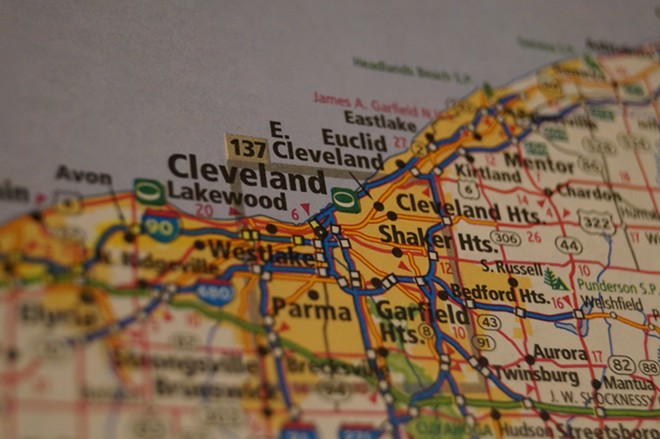Cleveland Tax Abatement Study Shows Inequity is Increasing, More Development Tools are Necessary
By Sam Allard on Wed, Jul 29, 2020 at 3:05 pm
[
{
"name": "Ad - NativeInline - Injected",
"component": "38482495",
"insertPoint": "3",
"requiredCountToDisplay": "5"
},{
"name": "Real 1 Player (r2) - Inline",
"component": "38482494",
"insertPoint": "2/3",
"requiredCountToDisplay": "9"
}
]
The City of Cleveland should continue to use its residential tax abatement program as a development tool, a team of consultants and local nonprofit professionals told City Council Wednesday morning. But if it's the only tool in the city's development toolbox, existing inequities could be exacerbated.
Researchers from Reinvestment Fund, Public Financial Management, Greater Ohio Policy Center, Neighborhood Connections and Leverage Point Development, in consultation with the city's office of community development, published a detailed report this week on the city's tax abatement program. Since 2004, Cleveland has provided 15-year 100-percent tax abatements on newly constructed home and residential developments, and similar abatements on the increased value of renovated homes.
The report recommended a number of policy interventions to ensure that neighborhoods like Tremont, Ohio City, Detroit-Shoreway and University Circle don't continue to see the lion's share of new investment. Though abatements were previously spread out across the city's neighborhoods, in recent years they have been increasingly concentrated in "trendy" areas.
"Given the cost of construction, a tax abatement alone is not going to spur investment beyond these hot neighborhoods," said Community Development Director Tania Menesse. "We need to help incentivize development in other neighborhoods with other tools."
Total abatements reached their peak in 2007, the report found, with more than 7,000 actively abated properties. The number of newly abated parcels has steadily declined since the Great Recession, but a larger percentage now goes toward multi-unit developments, so the total value of abated properties has remained roughly constant.
The study was initially undertaken out of desire to create a long-term equitable housing plan in the city and was rooted in hard data. It was accelerated by city residents' fears of displacement, particularly in neighborhoods where waves of new construction have increased home prices and the tax burden on legacy homeowners. Multiple councilmen said Wednesday that they'd heard repeatedly from constituents about fears of being displaced from the homes they've owned for decades because of rising taxes.
In spite of these fears, the report found only limited evidence that tax abatements lead to residential displacement, and only in two percent of the city's neighborhood blocks. (Those blocks, predictably, are in the same "high price, high pressure" areas where the abatements have been most highly concentrated.)
Nevertheless, the report recommended establishing a displacement threshold at which the city could adjust the time period and percentage of offered abatements based on market conditions. (St. Louis has a similar policy in place.) If median home prices rose above a certain percentage of an area's median income, say, the abatement could be lowered from 15 years to 5 years, or from 100 percent to 50 percent.
The report also recommended capping abatements for new single-family homes at $300,000. It noted that while 99 percent of the homes sold in Cleveland in 2017 and 2018 were for less than $300,000, fully 23 percent of the abated homes were. "Setting a cap at this level will primarily impact households for whom the abatement may not be the deciding factor in their purchasing
decisions," the report said.
For multi-family developments, the report suggested a "but-for" requirement for projects valued at over $5 million, which would provide an abatement only if the project could not be pursued without the city subsidy.
But the policy suggestion with the most interest from council was not directly related to the abatements themselves. It was a cap on property tax increases for longtime homeowners. Councilmen Kevin Conwell, Blaine Griffin, Basheer Jones, Kerry McCormack and others all said they'd heard from constituents about rising tax bills stemming from last year's Cuyahoga County home valuations.
Local FirstEnergy State Sen. Sandra Williams has an active bill seeking a statewide cap, and council members voiced their support for mechanisms of that kind which would protect existing homeowners while not discouraging new development. A tax cap was not included in the list of the report's official recommendations in part because property tax policy is set by the state.
Councilman Kerry McCormack, who represents most of the "high price, high pressure" neighborhoods identified in the report, stressed that Wednesday's hearing was only a piece of a larger conversation as City Hall develops what he called a "robust" housing policy. He said he hoped council wouldn't "punt" the recommendations of the report.
"My residents and I are ready to move forward with these recommendations, not in 2-5 years, but today," he said.
Community Development Director Tania Menesse said the recommendations were not designed to sit on the shelf. The task now, she said, is to "operationalize" them.
***
Sign up for Scene's weekly newsletters to get the latest on Cleveland news, things to do and places to eat delivered right to your inbox.
Researchers from Reinvestment Fund, Public Financial Management, Greater Ohio Policy Center, Neighborhood Connections and Leverage Point Development, in consultation with the city's office of community development, published a detailed report this week on the city's tax abatement program. Since 2004, Cleveland has provided 15-year 100-percent tax abatements on newly constructed home and residential developments, and similar abatements on the increased value of renovated homes.
The report recommended a number of policy interventions to ensure that neighborhoods like Tremont, Ohio City, Detroit-Shoreway and University Circle don't continue to see the lion's share of new investment. Though abatements were previously spread out across the city's neighborhoods, in recent years they have been increasingly concentrated in "trendy" areas.
"Given the cost of construction, a tax abatement alone is not going to spur investment beyond these hot neighborhoods," said Community Development Director Tania Menesse. "We need to help incentivize development in other neighborhoods with other tools."
Total abatements reached their peak in 2007, the report found, with more than 7,000 actively abated properties. The number of newly abated parcels has steadily declined since the Great Recession, but a larger percentage now goes toward multi-unit developments, so the total value of abated properties has remained roughly constant.
The study was initially undertaken out of desire to create a long-term equitable housing plan in the city and was rooted in hard data. It was accelerated by city residents' fears of displacement, particularly in neighborhoods where waves of new construction have increased home prices and the tax burden on legacy homeowners. Multiple councilmen said Wednesday that they'd heard repeatedly from constituents about fears of being displaced from the homes they've owned for decades because of rising taxes.
In spite of these fears, the report found only limited evidence that tax abatements lead to residential displacement, and only in two percent of the city's neighborhood blocks. (Those blocks, predictably, are in the same "high price, high pressure" areas where the abatements have been most highly concentrated.)
Nevertheless, the report recommended establishing a displacement threshold at which the city could adjust the time period and percentage of offered abatements based on market conditions. (St. Louis has a similar policy in place.) If median home prices rose above a certain percentage of an area's median income, say, the abatement could be lowered from 15 years to 5 years, or from 100 percent to 50 percent.
The report also recommended capping abatements for new single-family homes at $300,000. It noted that while 99 percent of the homes sold in Cleveland in 2017 and 2018 were for less than $300,000, fully 23 percent of the abated homes were. "Setting a cap at this level will primarily impact households for whom the abatement may not be the deciding factor in their purchasing
decisions," the report said.
For multi-family developments, the report suggested a "but-for" requirement for projects valued at over $5 million, which would provide an abatement only if the project could not be pursued without the city subsidy.
But the policy suggestion with the most interest from council was not directly related to the abatements themselves. It was a cap on property tax increases for longtime homeowners. Councilmen Kevin Conwell, Blaine Griffin, Basheer Jones, Kerry McCormack and others all said they'd heard from constituents about rising tax bills stemming from last year's Cuyahoga County home valuations.
Local FirstEnergy State Sen. Sandra Williams has an active bill seeking a statewide cap, and council members voiced their support for mechanisms of that kind which would protect existing homeowners while not discouraging new development. A tax cap was not included in the list of the report's official recommendations in part because property tax policy is set by the state.
Councilman Kerry McCormack, who represents most of the "high price, high pressure" neighborhoods identified in the report, stressed that Wednesday's hearing was only a piece of a larger conversation as City Hall develops what he called a "robust" housing policy. He said he hoped council wouldn't "punt" the recommendations of the report.
"My residents and I are ready to move forward with these recommendations, not in 2-5 years, but today," he said.
Community Development Director Tania Menesse said the recommendations were not designed to sit on the shelf. The task now, she said, is to "operationalize" them.
***
Sign up for Scene's weekly newsletters to get the latest on Cleveland news, things to do and places to eat delivered right to your inbox.
SCENE Supporters make it possible to tell the Cleveland stories you won’t find elsewhere.
Become a supporter today.
About The Author
Sam Allard
Sam Allard is the Senior Writer at Scene, in which capacity he covers politics and power and writes about movies when time permits. He's a graduate of the Medill School of Journalism at Northwestern University and the NEOMFA at Cleveland State. Prior to joining Scene, he was encamped in Sarajevo, Bosnia, on an...
Scroll to read more Cleveland News articles
Newsletters
Join Cleveland Scene Newsletters
Subscribe now to get the latest news delivered right to your inbox.















